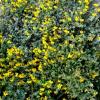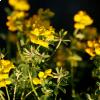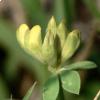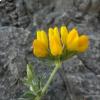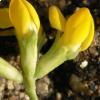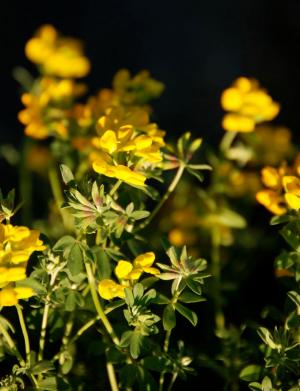Il Lotus cytisoides, noto come il Ginestrino delle scogliere, è diffuso nelle coste rocciose del bacino del mediterraneo. E una pianta erbacea perenne tipica delle zone costiere. Questa piccola leguminosa strisciante cresce nelle regioni del centro e del sud Italia. Nella Provincia di Salerno è facile trovarla lungo le coste da Positano a Sapri.
E' una specie camefita suffruticosa (perenne) appartenente alla famiglia delle Leguminosae.
La famiglia delle Leguminosae appartiene all'ordine Rosales; essa comprende un vastissimo numero di generi e specie. Sono rappresentate essenze erbacee (fra cui sono incluse anche alcune rampicanti che si aggrappano ai supporti per mezzo di viticci fogliari) e legnose. Queste ultime possono avere portamento sia arboreo che arbustivo.
Il Ginestrino delle scogliere è una pianta strisciante, dai fusti rossicci e dalle foglie più larghe nella parte distale e leggermente piegate al centro, che inizia a fiorire in primavera e a produrre velocemente baccelli in cui si sviluppano i semi.
Sia le foglie che i fusti appaiono carnosetti e sono quindi in grado di accumulare liquidi per far fronte a periodi di siccità intensa.
I fiori sono abbastanza appariscenti, giallo vivo, e sono portati all'apice di rami che, solitamente, si ergono leggermente da terra. Sono generalmente raggruppati in gruppi di tre o più fiori.
Il portamento è prostrato-ascendente, l'altezza raggiunge i 20-25 centimetri. I rami sottili e numerosi si sviluppano dalla base legnosa formando fitti cuscini di fiori e foglie.
Il frutto è un legume di colore scuro, sottile e cilindrico, lungo fino a sei centimetri.

The Lotus cytisoides, also known as the birdsfoot trefoil, has spread in the rocky coasts of the Mediterranean basin. And a perennial herbaceous plant typical of coastal areas. This small creeping leguminous plant grows in the regions of central and southern Italy. In the Province of Salerno it is easy to find along the coast from Positano to Sapri. It belongs to the family Leguminosae, which belongs to the order Rosales including a large number of genera and species. They are represented herbaceous species, including some vines that cling to the supports by means of tendrils, and woody.
The grey birdsfoot foil is a creeping plant, with reddish stems and large leaves in the most distal part and slightly bent at the centre, which begins to bloom in the spring and to quickly produce pods in which they develop the seeds. Both the leaves and the stems are able to accumulate liquids to cope with periods of intense drought. The flowers are quite showy, bright yellow, and are carried at the apex of the branches, which usually rise slightly off the ground. They are generally grouped into groups of three or more flowers.
Numerous thin branches develop from the woody base forming dense cushions of leaves and flowers. The fruit is a dark-coloured, thin, cylindrical, and up to six centimetres legume.
